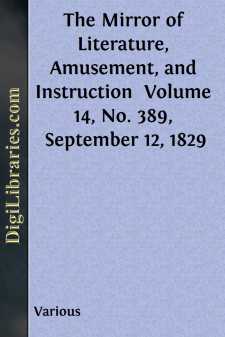Categories
- Antiques & Collectibles 13
- Architecture 36
- Art 48
- Bibles 22
- Biography & Autobiography 813
- Body, Mind & Spirit 142
- Business & Economics 28
- Children's Books 15
- Children's Fiction 12
- Computers 4
- Cooking 94
- Crafts & Hobbies 4
- Drama 346
- Education 46
- Family & Relationships 57
- Fiction 11828
- Games 19
- Gardening 17
- Health & Fitness 34
- History 1377
- House & Home 1
- Humor 147
- Juvenile Fiction 1873
- Juvenile Nonfiction 202
- Language Arts & Disciplines 88
- Law 16
- Literary Collections 686
- Literary Criticism 179
- Mathematics 13
- Medical 41
- Music 40
- Nature 179
- Non-Classifiable 1768
- Performing Arts 7
- Periodicals 1453
- Philosophy 64
- Photography 2
- Poetry 896
- Political Science 203
- Psychology 42
- Reference 154
- Religion 513
- Science 126
- Self-Help 84
- Social Science 81
- Sports & Recreation 34
- Study Aids 3
- Technology & Engineering 59
- Transportation 23
- Travel 463
- True Crime 29
The Mirror of Literature, Amusement, and Instruction Volume 14, No. 389, September 12, 1829
by: Various
Categories:
Description:
Excerpt
SION HOUSE.
SION HOUSE.
Taylor, the water poet, or Samuel Ireland, the picturesque Thames tourist, could not, in all their enthusiasm of jingling rhymes and aquatint plates, have exceeded our admiration of Sion House. Its whitened towers and battlemented roof are known to all the swan-hopping and steam navigators of our day, and none who have floated
To where the silver Thames first rural grows,—
can be strangers to the magnificence of the river-front.
Sion House stands in the parish of Isleworth, on the Middlesex bank of the Thames, and opposite Richmond gardens. It is called Sion from a nunnery of Bridgetines of the same name, originally founded at Twickenham, by Henry V. in 1414, and removed to this spot in 1432. This conventual association consisted of sixty nuns, the abbess, thirteen priests, four deacons, and eight lay brethren; the whole thus corresponding, in point of number, with the Apostles and seventy-two disciples of Christ. But the inmates were neither sinless nor spotless; many irregularities existed in the foundation, and consequently, Sion was among the first of the larger monastic institutions suppressed by Henry VIII. The estimated yearly value was 1,944l. 11s. 8-1/2d., now worth 38,891l. 14s. 2d.
After the dissolution of this convent, in 1532, it continued in the crown during the remainder of Henry's reign; and the King confined here his unfortunate Queen, Catherine Howard, from November 14, 1541, to February 10, 1542, being three days before her execution. Edward VI. granted it to his uncle, the Duke of Somerset, who, in 1547, began to build this spacious structure, and finished the shell of it nearly as it now remains. The house is a majestic edifice of white stone, built in a quadrangular form, with a flat and embattled roof, with a square turret at each of the outward angles. In the centre is an enclosed area, now laid out as a flower garden. The gardens were originally enclosed by high walls before the east and west fronts, so as to exclude all prospect; but the Protector, to remedy this inconvenience, built a high terrace in the angle between the walls of the two gardens. After his execution, in 1552, Sion was forfeited; and the house, which was given to John, Duke of Northumberland, then became the residence of his son, Lord Guildford Dudley, and of his daughter-in-law, the unfortunate Lady Jane Grey, who resided at this place when the Duke of Northumberland and Suffolk, and her husband, came to prevail upon her to accept the fatal present of the crown. The duke being beheaded in 1553, Sion House reverted to the crown. Queen Mary restored it to the Bridgetines, who possessed it till they were finally expelled by Elizabeth. In 1604, Sion House was granted to Henry Percy, ninth Earl of Northumberland, in consideration of his eminent services. His son, Algernon, employed Inigo Jones to new face the inner court, and to finish the great hall in the manner in which it now appears. In 1682, Charles, Duke of Somerset, by his marriage with the only child of Joceline, Earl of Northumberland, became possessed of Sion House: he lent the mansion to the Princess Anne, who resided here during the misunderstanding between her and Queen Mary....












